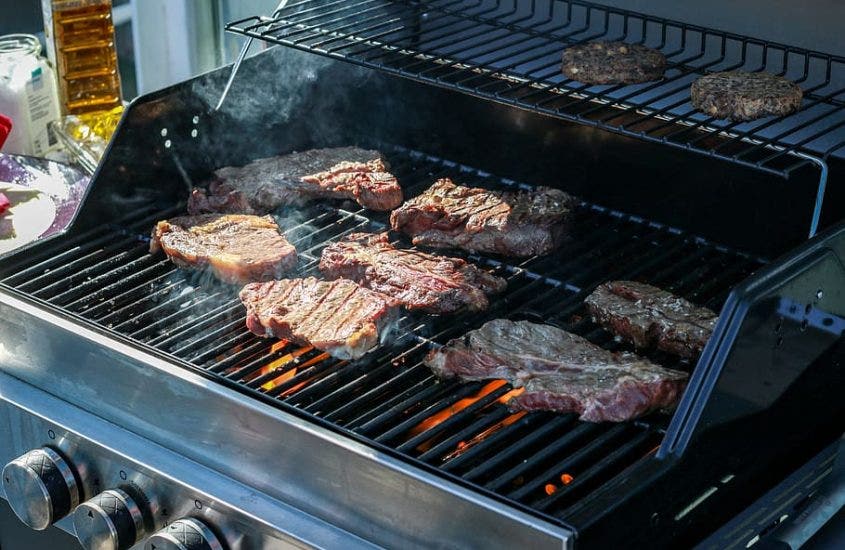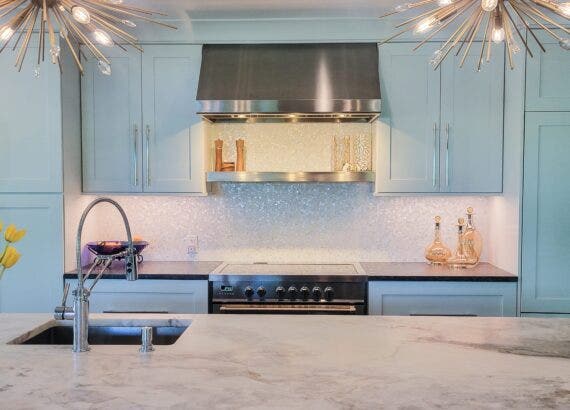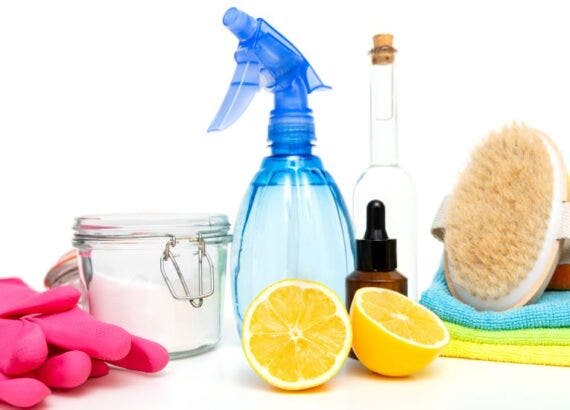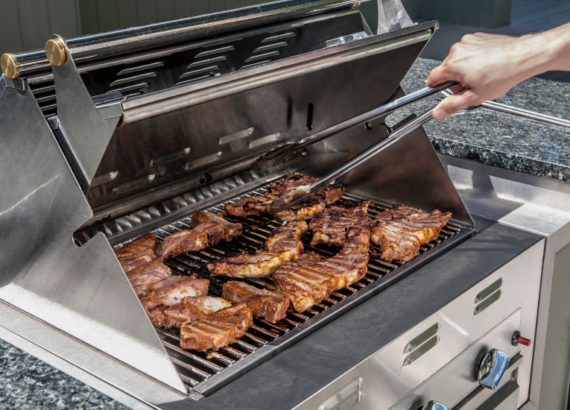How do I connect a natural gas grill to my house?

To connect a natural gas grill to your house, you need to hire a professional. Working with gas lines is dangerous, so do not attempt this without a professional present. A plumbing or heating contractor or a licensed gas fitter are your best options to install your natural gas grill.
If you have some experience and plan to pursue the gas grill installation yourself, be sure to have it inspected by a professional before use.
Also read: What Size Pipe Do I Need for a Natural Gas Grill?
There are two main ways to power your grill: propane or natural gas. Natural gas has several advantages when compared to propane.
- Cost-effective – natural gas is often less expensive than propane, which will save you money over time.
- Safe – Unlike propane, which is denser than air, natural gas is lighter than air. It rises, which prevents any dangerous buildup of gas from occurring.
- Convenient – No need to buy bulky propane tanks and hook them up to your gas grill. Also, you won’t have to refill natural gas like you do with propane, which makes it a reliable option.
- Portable – As long as you have the right cord to connect your grill to the home gas line, you can install your gas grill anywhere in the yard.
If you are looking to invest in a natural gas grill, then check out this article for our detailed step-by-step breakdown of the installation process. Refer to the video below to help with the installation.

Table of Contents
What You Need
This project requires several different materials. Your contractor should have all of these, but if you would like to purchase them, you can buy them on Amazon below.
- Pipe-joint sealant
- Galvanized steel straps
- Gas shutoff valves
- Drill and drill bits
- Dish soap
- Spray bottle
- Quick connect hose fittings
- Rust-Oleum Rustproof Spray Paint
- Pipe wrench
- Standard adjustable wrench
- Pressure gauge
1. Locate your gas meter.
2. Determine the capacity of the gas line running to your home by looking at the gas meter.
The gas meter should have a CFH reading or cubic feet per hour. Take the CFH reading and multiply it by 1000 to get the approximate capacity of your natural gas line.
This capacity can vary dramatically depending on the pressure of your natural gas line. For example, in the video, the meter is 210 cubic feet per hour, but the licensed professional said that 400,000 BTUs is running through the line.
Calculating this capacity can get complex, so be sure to consult an expert.
3. Determine what you have connected to that meter and how many BTUs each connection requires.
Depending on your home setup, you may have a furnace, gas range or oven, fireplace, or other gas appliances connected to your natural gas line. Each of these requires a specific amount of BTUs.
4. Locate an area in your home where you want to connect a new gas line that runs to your grill.
5. Shut off the gas line.
6. Remove the drip cap from your gas line.
7. Map out the shortest distance that your pipe can run to your grill and purchase the appropriate fittings.
8. Apply pipe joint compound to the connections.
Whenever you are attaching pipes and fittings together, use a pipe joint compound to prevent leaks.
9. Tighten the pipe using a pipe wrench and a standard wrench.
10. Support the pipe using a threaded rod with galvanized hangers.
11. Insert the pipes one by one and start connecting them together with fittings.
Tip: Install a shut-off valve on this pipe for extra safety. This way you have quick access to turn off the gas from the inside if necessary.
12. Drill a hole to the outside of your home where the pipe will run.
Be careful to not hit any electrical wires!
13. Measure out the final pipe that will run to the hole that you drilled in the step above.
14. Add a drip cap to catch any water that enters the gas line.
With this drip cap, your gas will flow smoothly and you will have minimal water or rust build up in the pipe.
15. Finish up the exterior connections and attach a pressure gauge to the pipe.
Check out the video below to see how the contractor completed the installation.
16. Test the pressure in the piping. Spray the connections with soap and water. If a bubble appears, there is a leak.
17. Wait about 45 minutes to one hour and then check the pressure gauge. The pressure should be the same.
18. Remove the pressure gauge and install a hose fitting for your natural gas hose.
19. Spray paint your gas pipe with rust-proof paint.
Cover the ends of the pipe and any valves with tape so you don’t get paint on them. Also, tape a piece of cardboard to your house so you don’t get paint on it.
20. Connect the quick connect gas hose to the fitting.
21. Turn the gas back on.
Now you’re ready to grill! But before you leave, we’ll answer some common questions about natural gas grills.
How much does it cost to hook up a natural gas grill?
Typically, installing a natural gas grill will cost between $200 and $400, according to HomeAdvisor. This includes running the gas line to your grill and then hooking it up.
Low-end installations may cost under $200, while high-end installations may cost up to $800.
Does a natural gas grill need a regulator?
For safety reasons, invest in a regulator for your natural gas grill. Natural gas grills require a pressure rating of 4” WC (inches per water column, a unit of pressure).
When you run the gas to different appliances like your water heater, furnace, or gas grill, pressure regulators decrease the PSI so that your gas lines remain intact. This is why it’s important to regulate the pressure running to your gas grill. Natural gas is supplied by your city or county at a specific pressure. Consult your contractor to determine this pressure.
Check out this popular natural gas (NG) regulator from Amazon.
How do you convert a propane stove to natural gas?
Swap out a small part in your grill called the orifice. You can find the orifice by unscrewing your grill panel and burners.
By swapping out the orifice, you can convert a grill from propane to natural gas or from natural gas to propane.
Click here for a short explanation on this topic.
Keep your outdoor kitchen clean with a durable vent hood.
Once you install your natural gas grill, be sure to install an outdoor range hood as well. It will keep the smoke and fumes produced from your grill outside of your patio. At Proline, our outdoor vent hoods are manufactured with a sleek outdoor-rated 304 stainless steel that is stain and scratch-resistant. Take a look at our professional outdoor hoods below.
That’s it for our article on how to connect a gas grill to your house. It’s not something we recommend that you DIY, but if you want to tackle the project, have a professional plumber or gas fitter inspect your work.
For more home improvement ideas, check out our articles below.
Related Articles
- 6 Outdoor BBQ Ideas for the Spring and Summer Seasons
- 6 Inspirational Outdoor Kitchen Bar Ideas
- Why do I need an outdoor range hood?
As an Amazon Associate, we earn from qualifying purchases.
How do I connect a natural gas grill to my house?
To connect a natural gas grill to your house, you need to hire a professional. Working with gas lines is dangerous, so do not attempt this without a professional present. A plumbing or heating contractor or a licensed gas fitter are your best options to install your natural gas grill.
If you have some experience and plan to pursue the gas grill installation yourself, be sure to have it inspected by a professional before use.
How much does it cost to hook up a natural gas grill?
ypically, installing a natural gas grill will cost between $200 and $400, according to HomeAdvisor. This includes running the gas line to your grill and then hooking it up.
Low-end installations may cost under $200, while high-end installations may cost up to $800.
Does a natural gas grill need a regulator?
For safety reasons, invest in a regulator for your natural gas grill. Natural gas grills require a pressure rating of 4” WC (inches per water column, a unit of pressure).
When you run the gas to different appliances like your water heater, furnace, or gas grill, pressure regulators decrease the PSI so that your gas lines remain intact. This is why it’s important to regulate the pressure running to your gas grill. Natural gas is supplied by your city or county at a specific pressure. Consult your contractor to determine this pressure.
Check out this popular natural gas (NG) regulator from Amazon.
How do you convert a propane stove to natural gas?
Swap out a small part in your grill called the orifice. You can find the orifice by unscrewing your grill panel and burners.
By swapping out the orifice, you can convert a grill from propane to natural gas or from natural gas to propane.
Click here for a short explanation on this topic.








Comments are closed.